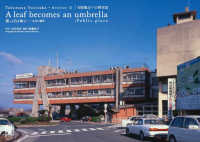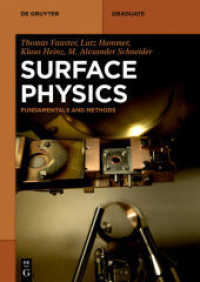- ホーム
- > 洋書
- > 英文書
- > Science / Mathematics
Full Description
This textbook offers a readily comprehensible introduction to classical Newtonian gravitation, which is fundamental for an understanding of classical mechanics and is particularly relevant to Astrophysics. The opening chapter recalls essential elements of vectorial calculus, especially to provide the formalism used in subsequent chapters. In chapter two Classical Newtonian gravity theory for one point mass and for a generic number N of point masses is then presented and discussed. The theory for point masses is naturally extended to the continuous case. The third chapter addresses the paradigmatic case of spherical symmetry in the mass density distribution (central force), with introduction of the useful tool of qualitative treatment of motion. Subsequent chapters discuss the general case of non-symmetric mass density distribution and develop classical potential theory, with elements of harmonic theory, which is essential to understand the potential development in series of the gravitational potential, the subject of the fourth chapter. Finally, in the last chapter the specific case of motion of a satellite around the earth is considered. Examples and exercises are presented throughout the book to clarify aspects of the theory.
The book is aimed at those who wish to progress further beyond an initial bachelor degree, onward to a master degree, and a PhD. It is also a valuable resource for postgraduates and active researchers in the field.
Contents
Chapter 1.- Elements of Vector Calculus.- 1.1 Vector Functions of Real Variables.- 1.2 Limits of vector Functions.- 1.3 Derivatives of Vector Functions.- 1.3.1 Geometrie Interpretation.- 1.4 Integrals of Vector Functions.- 1.5 The Formal Operator Nabla, ∇.- 1.5.1 ∇ in Polar Coordinates.- 1.5.2 ∇ in Cylindrical Coordinates.- 1.6 The Divergence Operator.- 1.7 The Curl Operator.- 1.8 Divergence and Curl by Means of ∇.- 1.8.1 Spherical Polar Coordinates.- 1.8.2 Cylindrieal Coordinates.- 1.9 Vector Fields.- 1.9.1 Field Lines.- 1.10 Divergence Theorem.- 1.10.1 Velocity Fields.- 1.10.2 Continuity Equation.- 1.10.3 Field Lines of Solenoidal Fields.- Chapter 2 Potential Theory.- Discrete mass distributions.- 2.1 Single particle gravitational potential.- 2.2 The gravitating N body case.- 2.3 Mechanical Energy of the N bodies.- 2.4 The Scalar Virial Theorem.- 2.4.1 Consequenees of the Virial Theorem.- 2.5 Newtonian Gravitational Force and Potential.- 2.6 Gauss Theorem.- 2.7 Gravitational Potential Energy.- 2.8 Newton's Theorems.- Chapter 3.- Central Force Fields.- 3.1 Force and Potential of a Spherical Mass Distribution.- 3.2 Circular orbits.- 3.2 Potential of a Homogeneous Sphere.- 3.3.1 Quality of Motion.- 3.3.2 Particle Trajectories.- 3.4 Periods of Oscillations.- 3.4.1 Radial and Azimuthal Oscillations.- 3.4.2 Radial Oscillations in a Homogeneous Sphere.- 3.4.3 Radial Oscillations in a Point Mass Potential.- 3.5 The Isochrone Potential.- 3.6 The Inverse Problem in Spherical Distributions.- Chapter 4.- Potential Series Developments.- 4.1 Fundamental Solution of Laplace'sChapter 1.- Elements of Vector Calculus.- 1.1 Vector Functions of Real Variables.- 1.2 Limits of vector Functions.- 1.3 Derivatives of Vector Functions.- 1.3.1 Geometrie Interpretation.- 1.4 Integrals of Vector Functions.- 1.5 The Formal Operator Nabla, ∇.- 1.5.1 ∇ in Polar Coordinates.- 1.5.2 ∇ in Cylindrical Coordinates.- 1.6 The Divergence Operator.- 1.7 The Curl Operator.- 1.8 Divergence and Curl by Means of ∇.- 1.8.1 Spherical Polar Coordinates.- 1.8.2 Cylindrieal Coordinates.- 1.9 Vector Fields.- 1.9.1 Field Lines.- 1.10 Divergence Theorem.- 1.10.1 Velocity Fields.- 1.10.2 Continuity Equation.- 1.10.3 Field Lines of Solenoidal Fields.- Chapter 2 Potential Theory.- Discrete mass distributions.- 2.1 Single particle gravitational potential.- 2.2 The gravitating N body case.- 2.3 Mechanical Energy of the N bodies.- 2.4 The Scalar Virial Theorem.- 2.4.1 Consequenees of the Virial Theorem.- 2.5 Newtonian Gravitational Force and Potential.- 2.6 Gauss Theorem.- 2.7 Gravitational Potential Energy.- 2.8 Newton's Theorems.- Chapter 3.- Central Force Fields.- 3.1 Force and Potential of a Spherical Mass Distribution.- 3.2 Circular orbits.- 3.2 Potential of a Homogeneous Sphere.- 3.3.1 Quality of Motion.- 3.3.2 Particle Trajectories.- 3.4 Periods of Oscillations.- 3.4.1 Radial and Azimuthal Oscillations.- 3.4.2 Radial Oscillations in a Homogeneous Sphere.-3.4.3 Radial Oscillations in a Point Mass Potential.- 3.5 The Isochrone Potential.- 3.6 The Inverse Problem in Spherical Distributions.- Chapter 4.- Potential Series Developments.- 4.1 Fundamental Solution of Laplace's Equation.- 4.2 Harmonic Functions.- 4.3 Legendre's Polynomials.- 4.4 Recursive Relations.- 4.4.1 First Recursive Relation.- 4.4.2 Second Recursive Relation.- 4.5 Legendre Differential Equation.- 4.6 Orthogonality of Legendre's Polynomials.- 4.7 Development in Series of Legendre's Polynomials.- 4.8 Rodrigues Formula Chapter 5.- Harmonic and Homogeneous Polynomials.- 5.1 Spherical Harmonics.- 5.2 Solution of the Differential equations for Sm(θ, ϕ).- 5.3 The Solution in ϕ.- 5.4 A note on the Associated Legendre Differential Equation.- 5.5 Zonal, Sectorial and Tesseral Spherical Harmonics.- 5.5.1Orthogonality Properties.- Chapter 6.- Series of Spherical Harmonics.- 6.1 Potential Developments Out of a Mass Distribution.- 6.2 The External Earth Potential.- 6.3 Exercises.








